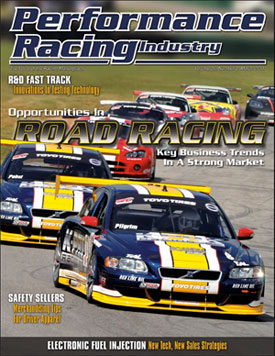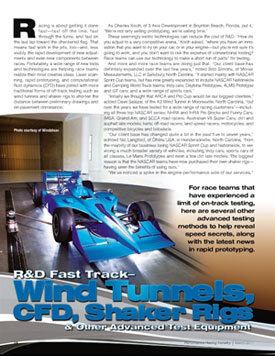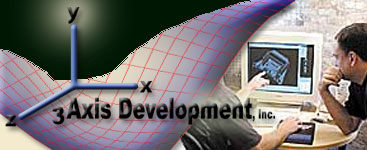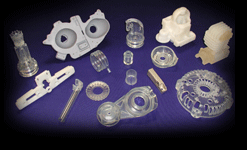|
||||||
Media - In the News
 R&D Fast-Track -
R&D Fast-Track -
Wind Tunnels, CFD, Shaker Rigs & Other Advanced Test Equipment
March 2011 | www.PerformanceRacing.com
Racing is about getting it done fast—fast off the line, fast through the turns, and fast on the last lap toward the checkered flag. That means fast work in the pits, too—and, less visibly, the rapid development of new adjustments and even new components between races. Fortunately, a wide range of new tools and technologies are helping race teams realize their most creative ideas. Laser scanning, rapid prototyping, and computational fluid dynamics (CFD) have joined with more traditional forms of off-track testing such as wind tunnels and shaker rigs to shorten the distance between preliminary drawings and on-pavement dominance.
As Charles Koch, of 3Axis Development in Boynton Beach, Florida, put it, “We’re not only selling prototyping, we’re selling time.”
These seemingly exotic technologies can reduce the cost of R&D. “How do you adjust to a very competitive arena,” Koch asked, “where you have an innovation that you want to try on your car, or in your engine—but you’re not sure it’s going to work, and you don’t want to risk the expense of conventional tooling? Race teams can use our technology to make a Short-Run of parts” for testing.
And more and more race teams are doing just that. “Our client base has definitely expanded over the last few years,” noted Bob Simons, of Morse Measurements, LLC in Salisbury, North Carolina. “It started mainly with NASCAR Sprint Cup teams, but has now greatly expanded to include NASCAR Nationwide and Camping World Truck teams; Indy cars; Daytona Prototypes, ALMS Prototype and GT cars; and a wide range of sports cars.”
“Initially we thought that ARCA and Pro Cup would be our biggest clientele,” added Dave Salazar, of the A2 Wind Tunnel in Mooresville, North Carolina, “but over the years we have tested for a wide range of racing customers”—including all three top NASCAR series; NHRA and IHRA Pro Stocks and Funny Cars; IMSA, Grand-Am, and SCCA road racers; Australian V8 Super Cars; dirt and asphalt late models; karts; off-road racers; land speed racers; motorcycles; and competitive bicycles and bobsleds.
“Our client base has changed quite a bit in the past five to seven years,” echoed Nic Langford, of Öhlins USA, in Hendersonville, North Carolina, “from the majority of our business being NASCAR Sprint Cup and Nationwide, to servicing a much broader variety of vehicles, including Indy cars, sports cars of all classes, Le Mans Prototypes and even a few dirt late models. The biggest reason is that the NASCAR teams have now purchased their own shaker rigs—having seen the benefits of using ours.”
“We’ve noticed a spike in the engine-performance side of our services,”reported Larry Carlberg, of Laser Design Inc. in Bloomington, Minnesota, “particularly manifolds. This part of our services has grown from one primary company five years ago to five current customers—some of whom have purchased scanning equipment to bring the technology in-house and serve their needs faster. We’ve also been involved in the capture of custom-fitted seats to relieve driver fatigue, custom-fitted helmets for enhanced safety, and engine components for space-study applications. The rate charged for these services has generally remained the same,” however, because scans are now faster and more accurate, “customers are paying less for scan data collection and processing than they were even two years ago.”
“The question then becomes, ‘How much would your engine builder charge for an extra 50 horsepower?’” said Salazar, “or, how much would it cost to reduce the power required by 50 hp in a wind tunnel? Due to rules or restrictions, some engines are already running at their maximum performance; in that case, no amount of money will add more horsepower. Your only option is to attack from the aero direction with the help of a wind tunnel.
”Koch summarized, “What’s changed is that people are under-standing what these processes can do for them.
”We’ll now examine just a few of the cutting-edge testing and simulation technologies available to modern race teams.
Scanning, Printing & Casting
An alternative process for constructing wind tunnel test models is FDM (fused deposition modeling), which offers the benefits of saving time, money and efficiency when compared to machining and model making. Fortus 3D Production Systems from Stratasys, in Eden Prairie, Minnesota, are based on the company’s patented FDM technology. FDM materials have proven to be strong in the additive manufacturing market. The mechanical properties of ABS-M30, polycar-bonate (PC), PC-ABS and polyphenolsulfone (PPSF) can withstand the forces and stresses induced as the airflow strikes the model’s surface in wind tunnel testing.
Companies and race teams can use FDM models directly from the system to the wind tunnel. In fact, Joe Gibbs Racing (JGR), which regularly tests scale models (40 percent scale) in a full-span, rolling-floor wind tunnel, makes many of its scale models with FDM’s PC-ABS material. In the tunnel, JGR simulates the aerodynamic loads on its race cars at conditions equivalent to 200 mph. Mark Bringle, technical sponsor manager at JGR, explained, “The strength of the materials allows the FDM parts to be tested at high wind speeds without the risk of failure.” He added that most of these models are put into the wind tunnels without any secondary finishing work.
Bringle noted that when JGR used other methods to create wind tunnel models, JGR was limited to approximately 75 to 100 models annually due to the time and labor involved. In contrast, over a recent 12-month period, JGR produced 750 parts with its Fortus system. With little direct labor needed and around-the-clock operation, models that would take a week or more to produce with machining or sheet metal fabrication are being completed in a few days with FDM.
According to Koch, the most significant recent advance in rapid prototyping has been in the range of materials avail-able. “New material options have accelerated testing for the industry,” he noted. In some cases, it is now possible to print/build a prototype in the final-production material. “With direct-metal laser sintering, for example, we can make very precise metal parts. We can even print stainless steel. Car parts tend to be larger, but we’ve made medical parts and gun parts and used them not for production but for rugged test modeling.
”Even so, “the new material options in rapid prototyping have allowed race teams to test new ideas before they invest in hard tooling and/or expensive metals”—titanium, for example. “With rapid prototyping you can use a material that’s not as expensive, but that can give you similar results—even though it might not be the final product.”
3Axis Development offers “rapid prototyping and short-run manufacturing services, including stereolithography, direct-metal laser sintering, rapid investment casting, and fast-track processes for sheet metal, injection molding, etc.” With some of these technologies, the making of the prototype part hasn’t changed as much as the process that makes the tooling. Traditional investment casting, for example, requires an expend-able wax tool; while in rapid investment casting, patterns are grown/printed by various rapid prototyping processes. Similarly, in processes from sheet-metal forming to injection molding, CAD/CAM technology has accelerated the manufacture of tools, dies, and molds...
Read full electronic version of article at PerformanceRacing.com


